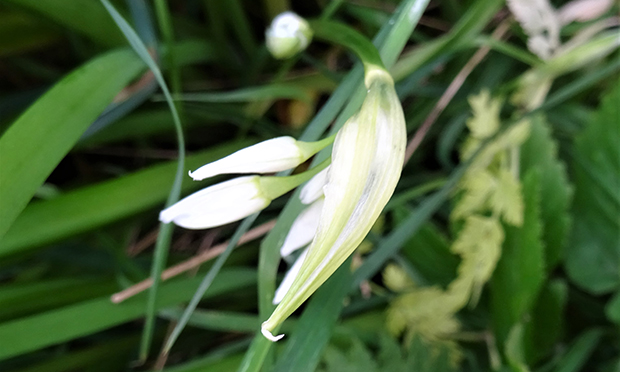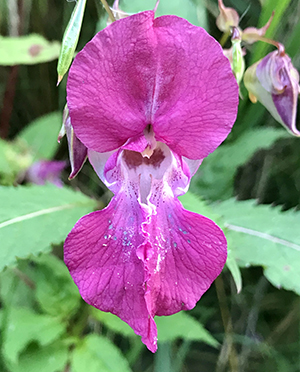The Citizen Gardener: Foraging to help, not hinder

Three-cornered leek, or Allium triquetrum
November brought with it a surprise bounty. For the past few weeks I have had my eyes trained on the ground, hand-fork at the ready and poised to pounce on any three-cornered leek I can find.
Three-cornered leek is a wild bulb plant and, due to the unseasonably warm Autumn weather, bulbs which would otherwise be quietly slumbering below ground, have thrust upwards. While this early awakening does not negatively impact the plants (the foliage will die back when the weather cools and the plant will reappear in Spring as normal), it does mean that they have revealed their hiding places. So while the soil is loose, such as it is at this time of year, now is the perfect time to remove them.
Otherwise known as onion grass, three-cornered leek, or its Latin name Allium triquetrum, grows in unabashed abundance across London. With its pretty bell-like white flowers and slender leaves, it is easily mistaken for a planted-on-purpose addition to our green spaces. Unfortunately, it has spread out of control in the UK. Its ability to multiply both by vegetative propagation and via seed means that it can quickly form dense monocultural swathes that wipe out any biodiversity in its path. In fact, it is actually an offence under Schedule 9 of the Wildlife and Countryside
Act in England and Wales to plant or otherwise cause to grow this species in the wild.
Happily though, Allium triquetrum is entirely edible. The whole plant – bulb, leaves, flowers and seeds – has a sweet onion-garlic flavour that works wonderfully chopped into salads, made into a pesto (as my full freezer is testament to), or indeed in any other recipe where you would use spring onion or leek. This makes it one of the few wild plants in the UK that you can forage without fear of negatively impacting the natural environment.

Himalayan Balsam. Photograph: Tim Green / Flickr
Foraging has had a renaissance over the past few years. Arguably the oldest and most primal relationship with the earth we have, it is a skill that fell by the wayside as industrialised food production systems grew. It is amazing to think that just a few generations before ours, foraging was part of daily life, a life that was more in tune with the natural world.
Urban foraging allows us to connect with nature in a hands-on way which in turn encourages what some call ‘pro-environmental behaviours’. It is a way to learn about and care for our depleted natural world. But, and that’s a big but, only if it is done responsibly.
We live in a changed world to that which was there for people foraging in Hackney a century ago. Ours is a natural world that is under immense strain so we have to be mindful of the environmental ramifications of what and how we pick.
Inevitably, the huge resurgence of foraging has brought with it problems of over-picking and degradation of natural areas in the city.
Regardless of how careful people are to stick to the tenets of responsible foraging – do no harm, tread lightly, take little, give back, never harvest rare plants – the growing interest in the pursuit coupled with the limited green spaces available to the millions of people in the city, is causing increasing environmental concerns.
Take the over-picking of mushrooms in Epping forest for instance, or the near eradication of wild garlic in Abney Park Cemetery.
Picking and eating invasive plants such as Allium triquetrum can benefit us all though. It enables us to reap the benefits of foraging while being a help not a hindrance to our green spaces. There are plenty more plants to look out for that will satisfy your foraging needs while improving the place you pick from.
Himalayan Balsam
Himalayan Balsam is one of the UK’s most invasive and problematic plants. You’ll find it along riverbanks (there’s a long stretch of it by the River Lea in the marshes) but it also grows in gardens and parks. It grows rapidly and spreads quickly, smothering other vegetation as it goes. It spreads via a very impressive seed-catapulting method which can cast the seeds up to seven metres away. Ideally you should remove the plant before it manages to produce seeds as this will slow the spread. However, if you don’t get to it in time, then the seeds will provide you with a tasty snack, with a flavour akin to sunflower seeds. Each plant has about 800 seeds, and the more of them you gather and eat, the fewer there will be to germinate in our soils.
Chickweed

Chickweed
Chickweed grows abundantly in London and can be a nuisance to vegetable growers. My carrot patch for instance is now a chickweed patch, contrary to my constant efforts to pick it out. Thankfully, it is rich in vitamin C and tastes rather lovely, especially tossed in a salad. If you eat it when it’s young the leaves have a delicious sweet flavour.
Stinging Nettles
Stinging nettles need no introduction. They grow all over the UK and are in no danger of over consumption. Often written off as the thugs of the hedgerow and the bane of the school playing field, the humble nettle actually has many unseen charms. Like other leafy green plants, it’s rich in fibre and protein and is easy to play around with in recipes. I like it as a green addition to a soup, just stir it in like you would spinach, or keep it simple and make a fresh leaf tea. Be sure to harvest just the new growth as the older leaves can be tough and bitter.
In Hackney, we are lucky to have an abundance of local knowledge to draw from. It is important to seek out people who have the skills and experience to guide you on your sustainable foraging journey, whether that be a knowledgeable neighbour or one of the many local guides. Hackney Herbal are wonderful, or Rachel de Thample does a lot of work with Made in Hackney. These experts will always be sure to remind you of the big rules, so remember don’t forage unless you can do so responsibly, never munch on a hunch, never forage from a herbicide or pesticide spray area, and most importantly, go lightly.
Do what is best for the natural world and we will continue to have food to forage for the future generations of Hackney.
Steph Goward is a trained, award-winning gardener. She is the new postcode gardener for E5, a horticultural therapist at St Mary’s Secret Garden, and works with a number of gardening groups across Hackney.
